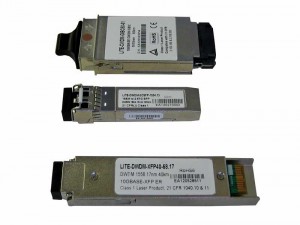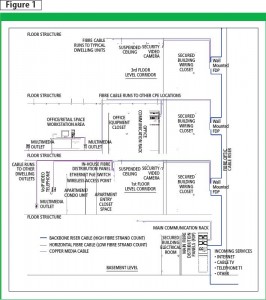Fibre-optic communication in modern buildings

Photo courtesy Telecom Engineering
The vertical riser fibre-optic cable is the building’s high-capacity communication backbone. It typically has a high fibre strand count and distributes groups of fibres assigned to each floor’s fibre distribution panel (FDP). One or more fibres per floor are allocated to each tenant or service, depending on design. Since an optical-fibre strand has a small diameter, even with a high fibre strand count cable the riser-cable diameter is typically less than 20 mm (0.8 in.). For low-rise buildings or campuses, this backbone cable runs horizontally to various distribution locations throughout the property.
The cable is often run in a large physical ring topology where access to any two sites is possible from both directions in the ring; this increases communication availability. In the event the backbone cable is cut or damaged at any location, the fibre-optic electronics redirects the communication to the other ring direction and is able to avoid communication failure.
For the horizontal section, individual cables are dedicated and routed to each tenant or service from the riser FDP. This cable has a lower fibre strand count—typically one to six fibres—with a diameter of less than 10 mm (0.4 in.). It is often hidden above suspended ceilings, in conduits, or walls. Esthetically appealing, wall-mount type fibre-optic cable or wall duct is available for locations where placement of hidden cable is impossible. In some cases, depending on fibre-cable type and location, placement may be required in a metallic conduit and CE Code should be referenced for details.
The fibre-optic cable type is selected to best protect the glass optical fibres for the installation environment and to meet all electrical and building codes. Again, CE Code and NBC should be referenced. In a typical commercial office building, a nonconductive fibre-optic cable is considered for both vertical and horizontal sections. A heavy-duty and high strand count cable in the vertical section provides good optical fibre protection. For the horizontal, section a flexible cable with a smaller strand count is helpful in routing fibres to each individual tenant location. This provides for good flexibility in building fibre-optic cable routes.
If rodents are a concern within the cable placement area—or additional cable protection is required—a steel-armoured cable is used, or the cable is placed into a metallic or polyvinyl chloride (PVC) conduit. Metallic armoured cables and conduit must be properly grounded. Other considerations for cable selection include proper cable fire rating, loose tube, and tight buffer cable types.
Optical fibre types
There are two main optical fibre types to consider for a system: multi-or single-mode fibre. Both are available with various characteristics and have advantages and disadvantages. Multi-mode fibre transmission is limited by its length and transmission speed. It is typically used in short intra-building and intra-office systems, and is a lower-cost optical transceiver. However, multi-mode optical-fibre cable is often more expensive per unit length than single-mode fibre cable. Single-mode fibre does not have the same limitations and is available for any transmission distance and speed including intra-building, metropolitan, and long-haul systems.
On each floor where the vertical backbone riser cable meets the horizontal cable, a secure wall- or rack-mount FDP can distribute the appropriate optical fibres. The FDP allows for horizontal cable fibre strands to be easily cross-connected to the appropriate vertical cable fibre strands to extend a tenant’s fibre-optic communication link to other building floors, or an outside network. It also permits the simple reconfiguring fibre assignments throughout the building over time as tenants move in and out without needing to re-cable.

Image courtesy Telecom Engineering
Depending on communication requirements and property layout, there are numerous fibre-optic cable deployment plans. One possibility consists of a hybrid fibre and copper cable solution. Fibre-optic cable is deployed in the building’s vertical backbone and horizontal segments to office equipment closets or area distribution locations. In each equipment closet, fibre-optic-to-copper-cable conversion electronics are deployed to transmit the signal over copper cables for the last few metres to the desktop or application, as seen in Figure 1 (page 108). For residential systems, fibre-optic cable is run from the outdoor pedestal backbone cable (i.e. the vertical riser in apartments or condominiums) to a distribution location in the home, typically on a closet or basement wall. Here, fibre-to-copper conversion electronics are installed and copper cables are run everywhere else in the home. This is referred to as fibre-to-the-home (FTTH) type of deployment.
Helpful building communication cabling standards include:
- Telecommunications Industry/Electronic Industries Alliance (TIA/EIA) 568-B, Commercial Building Telecommunications Cabling Standard;
- ANSI/National Electrical Contractors Association (NECA)/BICSI 568-2006, Standard for Installing Commercial Building Telecommunications Cabling; and
- ANSI/TIA 1005-A, Telecommunication Infrastructure Standard for Industrial Premises.
Conclusion
A well-planned fibre-optic communication system provides a powerful communication infrastructure throughout a property. However, it is important to weigh the benefits with the overall costs involved in deploying and maintaining this technology for each property.
Bob Chomycz, P.Eng., has engineered and deployed telecommunication networks for more than 25 years. His fibre-optic designs range from intra-building fibre-optic systems to cross country long haul fibre-optic networks. Chomycz is the author of three fibre-optic communication books (published by McGraw-Hill) and is president of Telecom Engineering, a company specializing in the engineering and installation of fibre-optic networks globally. He can be contacted at bchomycz@telecomengineering.com.
For more on fibre-optic communication, click here.







